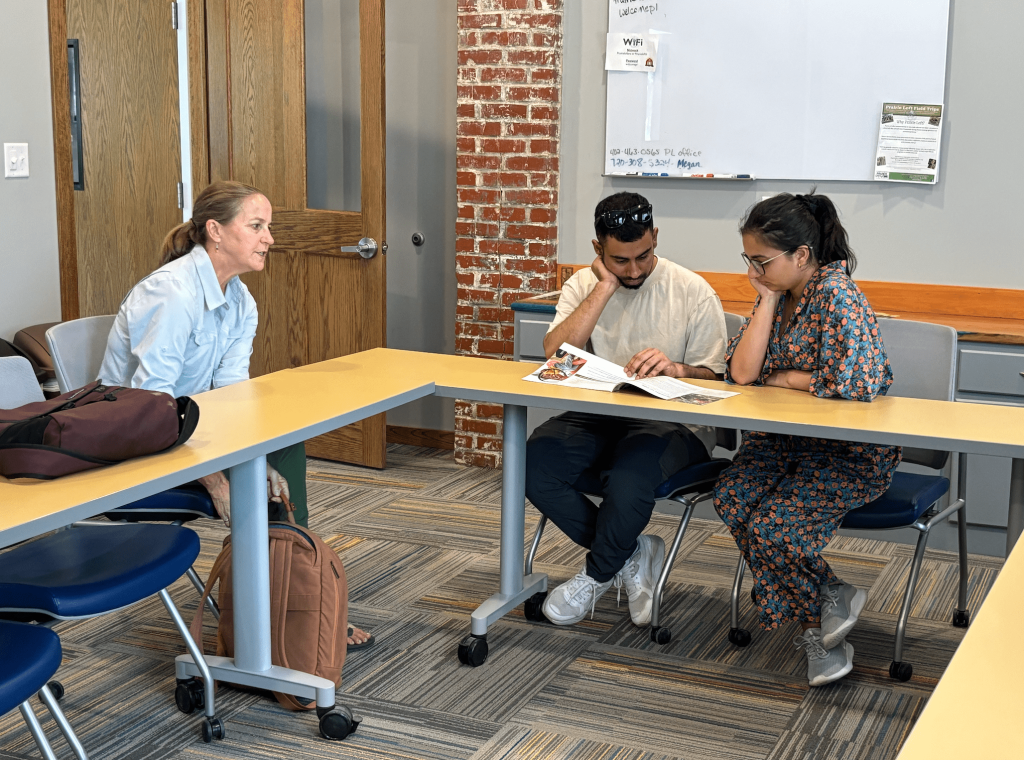
When we arrived in Nebraska, we were initially struck by how different it is from Nepal, yet at the same time, how similar our experiences are. Despite the vast geographical and cultural differences, we face many shared challenges like youth out-migration, the decline of towns and villages in search of better opportunities, and the diminishing sense of community belongingness.
However, what stood out to us was the hope and resilience found in these small towns in Nebraska and the ways they are working to reshape their futures, not just through infrastructure or financial investments, but through a shared vision and collective action that genuinely empowers local people. Here, we were surprised to witness the true model of community philanthropy, which is slowly transforming the futures of these small towns. In a time when there is a lot of skepticism surrounding “international aid” and funding from international actors is being reduced, we wonder how solutions to many grassroots struggles come from within, driven by the communities themselves rather than external aid.
Learning from Nebraska
Our experience began in Red Cloud, where we participated in a farm tour. Here, we learned about advancements in technology-driven farming, such as precision tools and automated machinery, which have significantly increased efficiency and productivity in small-town agriculture in the US. While technology has boosted productivity and brought economic benefits, it has also weakened people’s connection to their land and communities. Unlike traditional farming, modern methods require fewer people to work in large areas, leading to a growing sense of detachment from the land. Similarly, the widespread use of heavy pesticides, particularly nitrates, has contaminated groundwater and put local aquifers at risk, raising serious concerns about the future of farming and the health and well-being of the community. Although there is reluctance to change due to the current economic benefits, this situation has prompted us to reflect more on a balanced approach that incorporates technological advancements, community belonging and environmental sustainability, especially in the context of Nepal, where farming still remains more traditional and community-based.
Despite the vast geographical and cultural differences, we face many shared challenges
To address this and similar challenges, where economic gain is prioritized over community growth and development, the Nebraska Community Foundation (NCF) is adopting the Asset-Based Community Development (ABCD) model. ABCD model emphasizes identifying and leveraging the existing strengths and resources within a community, rather than relying on external solutions. ABCD has highlighted locally rooted challenges and has encouraged, co-created, and led collective action by the community itself. One of the most important lessons we learned from the Nebraska Community Foundation, especially being an activist from developing a nation is that every community possesses its own unique strengths. Whether in its history, people, culture, or resilience. However, the key to success often lies in identifying those strengths, investing in them, working together, and believing in their value. It is this sense of shared purpose and local empowerment that can bring both economic and emotional benefits to a community, something we urgently need in ‘external aid-dependent’ developing countries like Nepal. To our surprise, all four towns we visited in Nebraska demonstrated similar progress in mindset, behavior, and infrastructure, each expressed in its own distinctive form.
Local leadership in action
In Red Cloud, strategic investments – mainly developing the childhood home of Willa Cather into a tourist destination and building necessary infrastructures like hotels and museums in the center of the town – have helped shift local mind-sets from “we have nothing” to “we have something to share.” Similarly, the development of the Valley Child Development Center has offered high-quality early childhood education, demonstrating that a strong future for children can be built even in small towns like Red Cloud. Such efforts have fostered a greater sense of belonging, which has inspired people to return to their hometown by investing in local possibilities.
In Leigh, however, community development efforts have ranged from investing in local infrastructure like lakeside recreation areas to long-term commitments to youth, which have strengthened community-led discussions and decision-making. The Youth Advisory Committee (YAC), a group of local youth who meet regularly, has fostered greater inclusion in civic decisions, enhancing overall community well-being. Their efforts have also influenced local educational institutions by promoting STEM education and encouraging educated individuals to return and teach. An exceptional example of youth leadership is their investment in local real estate to provide affordable housing and attract families back to their town.
Similarly, in Diller, we witnessed NCF’s efforts in shaping young minds through programmes like “Serviceship Camps”, where, by engaging children and adolescents in real-world problem-solving and entrepreneurship, the community is working to nurture leadership, responsibility and a deep connection to the community.
Taking this approach one step further, in Hastings, the community has created and is emphasizing experiential and place-based learning methods for young people, which prioritize real-world engagement and reflection. When the world is moving towards tech-based learning, the work of Prairie Loft Center for Outdoor and Agricultural Learning shows that the community is ahead in understanding the effects of the overuse of technology. As a result, they are already working towards balancing real-life and digital elements in education. This unique learning approach has helped young people build stronger social connections, critical thinking skills, and a healthier relationship with technology.

The spirit of power sharing
All this community work shows NCF’s genuine commitment to power-sharing, a core value that sets it apart from traditional civil society organizations. Instead of holding authority, NCF shares it with communities, empowering them to make decisions that address their unique needs. This bold approach has therefore fostered trust, accountability and collaboration in the community, which has paved the way not just for infrastructure, but also for emotional and mind-set development. One striking example is the Hometown Internship programme, where young people are not sidelined into administrative tasks, but are entrusted with real responsibility. In most of the development organizations, young people are delegated to routine administrative tasks, missing out on real opportunities to lead and learn. In contrast, NCF’s Hometown Internship model gives youth the chance to collaborate, contribute and take ownership of their community’s future. Through NCF’s power-sharing approach, we saw how investing in young people and trusting them with real responsibility creates confident leaders and resilient communities. At its core, this reflects the essence of community philanthropy: shifting power to local people, valuing local knowledge and fostering collective action.
Reimagining development
In today’s context, where international aid is shrinking and trust in global institutions like the UN and development agencies are declining, the need to reimagine development has become more important than ever. Although it has several impacts of its own, it has somehow urged us to challenge top-down, donor-driven models and has forced us to rethink a new vision, one that is locally-led, culturally rooted and powered by the people themselves.
In today’s context, where international aid is shrinking and trust in global institutions like the UN and development agencies are declining, the need to reimagine development has become more important than ever
When we visited Nebraska, we didn’t expect to find lessons that would resonate so deeply with the challenges faced by communities back home in Nepal. Yet, in these small American towns, we saw the future of development, not paved by big aid, but built through trust, shared purpose and community-driven action. This experience compelled us to look inward rather than outward. Nepal, too, has a rich tradition of giving. Everyday, people donate to temples, monasteries and religious causes with unwavering faith. Yet, this powerful culture of giving has rarely been directed toward long-term community investment,in education, local leadership or infrastructure.
Inspired by NCF, developing countries like Nepal could begin experimenting with community endowment funds, seeded by cultural giving, tourism earnings, or remittances. Civil society organizations should develop the capacity to manage such funds in the most transparent way, which could become powerful tools for self-sustaining development. Religious institutions, diaspora communities and local tourism businesses could become foundational partners, transforming giving into investing, because it will create reinvestment opportunities in such areas like what we witnessed in Nebraska. But, it is not as simple as it is said to be done. Cultural issues, hierarchical traditions, short-term mind-sets, and resistance to change still hold back transformative thinking in Nepal. But framing community philanthropy within our own cultural narratives, like dana (charity), guthi (social institution) can become a starting point to bridge the gap between tradition and innovation in giving. If we can redefine faith in terms of sustainability and future generations rather than just devotion, then we can surely see some progress in community development.
Local ownership, global learning
What we saw in Nebraska wasn’t complex, there were no massive budgets or global experts and consultants. It was simple trust within local people, in youth, and continuous work towards the local vision. This has given us the understanding that shifting mind-sets, whether in Nebraska or Nepal, doesn’t begin with money. It begins with belief. Belief in people’s potential, in their ability to lead. Countries like Nepal are surely different in many ways from states like Nebraska; however, one strong lesson that can be universal is the concept of development rooted in local power, not external approval. Therefore, now we need to start identifying local assets and stop viewing community members as passive beneficiaries.
The future of development, whether in the Global South or rural America, depends on how boldly we are willing to share power, build trust, and invest in community leadership. Because when people are given the space to lead, they rise and communities grow. When power is shifted to those closest to the challenges, real lasting change becomes inevitable.

